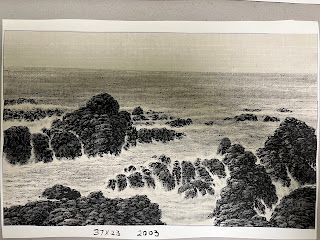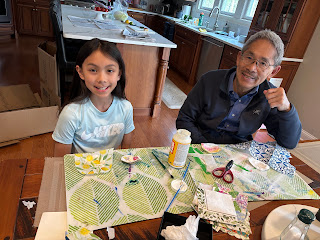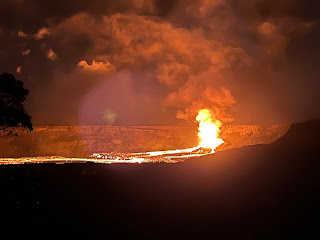Teh-cheong “TC” Chang, aged 95, passed away peacefully during the early morning of August 30th, 2025 at his ‘assisted’ apartment in Houston.
My parents became close to them nearly 60 years ago through my art historian father’s interest in Margaret’s abstract ink painting. TC and Margaret would join my parent’s wedding anniversary, birthdays and memorial celebrations and travel together in the US, to Asia and Europe to view Chinese paintings. Although I have known them over 50 years since Margaret graciously inked a painting for Teri and my wedding invitation, we three became especially close after Teri and my parent’s passing to the point that TC became my ‘tennis uncle’ and Margaret my ‘art auntie’. I stayed with them more than a dozen times in their condo overlooking Hermann Park in Houston, visiting several times a year. Just recently I realized that it was a special place that reminded me of my parents’ home, every wall adorned with ink paintings and every flat surface piled high with art books or art objects. The two of them always welcomed me with warmth, slowed my frenetic pace and shared insights from their life’s vignettes with me, always like a return home.
I wanted to share a few reflections as I happen to spend the last few days with TC before his passing.
TC’s professional life was as an accomplished architect who served as one of the principals on the Chicago O’Hare Airport and the uniquely domed Washington DC Subway (Harry Weese). He was the main architect of the Cincinnati Contemporary Art Museum, a suburban Chicago County Court complex, and the Milwaukee Symphony Hall, where Teri and I listened to concerts. And also, you name it whether underground or on the water, his portfolio included houses, parking garages, tennis and yacht clubs. As he told me, it was not easy making a living as a full-time architect in those days which underscores how good he was.
After designing a tennis center and given a free membership, TC took up tennis at the advanced age of 42 and began his ‘semi-professional’ avocation. Fast forward to a phase when his peers were using canes, he was playing tennis 3-4 times a week and won the prestigious gold ball as #1 USTA 80-85 Men’s Doubles Team having survived 80 of the top-seeded US teams through single elimination play!! He readily admits that his partner Russell Seymour was the elite one, yet he selected TC! In another astounding feat he and Margaret won the Houston mixed doubles age group championship multiple times. Although I never got to see him in tournament play, I suspect his consistency, ball placement and court strategy – he told me he was the master of the lob – served him well against towering 6-footers and former US Open and Wimbledon players. We bonded over tennis as TC always gave me tips on the court and would arrange for me to hit with Lori McNeil, his pro trainer, herself a former US Open and Wimbledon semifinalist. Yet where was the trophy case for the more than 50 trophies I could locate? Nowhere in evidence. These prizes were utilitarianly being used as serving plates, drinking cups and miscellaneous storage, and Margaret frequently would point out in their living room ‘oh, that’s another trophy’. I think Margaret’s quote ‘I may be a small person but my [ink] brush is powerful!’ could be repurposed for TC as ‘I may be short, but I wield a big raquet’!

TC developed RSV pneumonia and cardiac issues in early January and was hospitalized nearly continuously until April 15th. I visited him both in January and April, and although bedridden and not up to talking, I managed to bring him Chinese noodles from the stir-fry bar much to his relief. We all knew he had been pointing to the opening of Margaret’s solo retrospective at the Asia Society Texas on the 16th. But up until the day before, his attendance was completely unsettled, as he was so weak and listless that he was being considered for hospice. But he ‘rallied’ and 'woke up' the day before with all of the out-of-town family, almost as if given a dose of adrenaline. Within a 24-hour window, he was discharged from the hospital and transported by ambulance back to assisted living for the night. Then, with the help of a slew of nephews and grandnephews Paul, Fred and Simon, support aides and wheelchair, he made it to the opening! And to complete the mission impossible, he was whisked directly from the opening to a rehabilitation facility. Knowing TC and his ‘rallies’, we were amazed but not surprised! It was very heartwarming to see TC and Margaret at the pinnacle together, knowing how ill he was.

Given that a good group of family were present, we held an early celebration for his 95th birthday at the rehabilitation hospital, with his favorite dishes including Chinese-style lobster with ginger and scallions.
Remarkably after his family and I dispersed to home with great trepidation about his precarious medical status, his health roller coaster of the spring yielded to a level track between April and August. Although in a weakened, non-ambulatory state, he was still able to consume his daily Wall Street Journal, enjoy his favorite Chinese cuisine, and win at bridge, always the competitor!
Again, he roused for Margaret’s birthday celebration at the Asia Society Texas on the August 23rd with the help of Paul and myself. This was another grand celebration of Margaret’s art life and her relationships from teaching Tai Chi and calligraphy. It was attended by 135 enthusiastic supporters who listened to two lectures and shared in a double-tired cake designed after one her paintings.
During the same weekend we shared a seafood dinner with TC, Margaret, Cindy (Margaret’s cousin), Eric (Cindy’s son), Paul and I at Confucius Restaurant where we ordered ‘his’ desired double lobster special and as usual he ate with gusto.
On the 25th, though I did not know it then, I shared his last lucid evening. It began with a dinner at his favorite Vietnamese restaurant Lua Viet Kitchen where we managed the in/out transition by wheelchair without the benefit of a ramp. He ate pho and beef with rice noodles with aplomb. Back at their apartment, AJ, his long-time cardiologist-tennis buddy made his daily home visit. You heard that correctly, a cardiologist who makes home visits, but only to TC as they bonded nearly 40 years ago over tennis and the Colorado Rockies.
After the home visit, I updated TC on the next exhibitions and museum donation plans for Margaret’s work. Every so often he would interject ‘That’s good’. I asked him about additional exhibition venues and he astutely suggested Singapore, where indeed, they held a recent retrospective of Liu Kuosung, the founder of the famous 5th Moon Group avant garde group where Margaret was the main woman artist. We had not thought of that!
I then asked TC about his most favorite architectural project. I fully expected the answer to be the Washington Subway or the Milwaukee Symphony Hall, but instead he mentioned one unbuilt design and one custom house. In the first, he and Y.C. Wong submitted one of 300 applications for the Boston City Hall design competition and they made the final eight. When each of those eight teams made their final pitch with model, TC’s design came in second, but he staunchly maintained theirs was better than the winning design because of its contemporary design and internal ‘flexibility’ (movable walls) that enabled greater aesthetic appeal, functionality and longevity – indeed that building has since been torn down. The one that didn’t get built that had his full stamp, architectural prowess and peer approval was still dear to his heart.
The other, another surprise, was one of his smallest projects, a custom house and studio on Hornby Island (off Vancouver Island BC) for Margaret’s art students the Weiss’. This site was where Margaret spent parts of the summers of 1974-77 and inspired her 'Hornby Island' artistic phase where she sketched en plein air and later painted small animated landscapes of rocks, wind-swept trees/roots and driftwood. There on the isolated island terrain, TC surmounted challenges that included a dearth of available labor, earth movers, and even improvised using driftwood to supplement the limited lumber supply. He told me the owners wanted a single bedroom, but he overrode them in prescient fashion and add a flexible 25’ square space that eventually accommodated their two children!
I think TC’s choice of two projects that no one else would see are revealing. It wasn’t simply the magnitude or prominence of the project that made it memorable, it was the uniqueness and challenges he overcame that made them stand above all the recognizable ‘big name’ projects.
The following morning TC began to slip away and became minimally responsive just before I left. I gave him a final hug, said a few words to him, as tears swelled in both Margaret’s and my eyes.
TC was one of the most optimistic and resourceful people I’ve ever encountered. When he didn't get an architectural summer job in Chicago (already filled), he went back and queried whether they needed draftsman, which they did! When describing how he survived a massive heart attack, he identified being so close to Houston’s medical mile, promptly receiving stent placements, and the ‘boutique’ cardiology care from his buddy AJ. He was relentlessly positive in recounting these tales of challenge. As a Chinese immigrant in the 1950’s when prejudice abounded, he was able to thrive professionally. On multiple occasions during his architectural career, opportunities came serendipitously, and, from his skills. When queried about his opinion on potential problems on a design for a Hong Kong skyscraper, his many insights led him to a job working for one of the top real estate developers there.
Where did TC’s character come from? TC said his father taught him the game ‘go’ (Chinese chess) as a metaphor for life, ‘always think and plan several steps ahead.” After TC began beating his father as a youngster, his father took him to play his adult go-playing friends with a little side wager. TC invariably won and, with an impish grin, told me that that is how he got his spending money in grade school. That anticipatory sense was omnipresent and served him well throughout his life. And his positivity and openness enabled him to get along with anyone, even amongst the bastion of white tennis giants.
At first, TC’s out-sized architectural accomplishments and ‘racquet-teering’ (as president of the Houston Tennis Association) impressed me, but increasingly as I helped Margaret secure her long overdue her solo retrospective exhibition, I began to appreciate fully his iremarkable partnership with and support of Margaret. TC had tasked me with this exhibition project and told me he wanted it to happen and ‘cost was no issue’.
What distinguished TC from many accomplished Chinese peers of his era was his unwavering support of his other’s aspirations. From the beginning of their relationship, he enabled Margaret to pursue her artistic dreams to their fullest. Margaret acknowledges that TC’S financial support meant that she never had to rely on selling paintings to make a living, potentially being stuck in a commercial rut. After completing the Cincinnati Contemporary Art Center, he suggested Margaret as a potential solo artist, and voila. TC encouraged her to accept the teaching job at Chinese Hong Kong University halfway round the world until he could find a job there. When we traveled together to Asia Week in NYC, the Freer (Smithsonian) Gallery and Vancouver, Margaret drove the art agenda while TC served as the trailing spouse providing all the support services. Finally, their home speaks loudest where TC is relegated to the dark northside bedroom for his office and storage of her oil paintings. The remainder of their sunny living space is fully arrayed with her paintings, her large painting tables flush with art supplies, every flat surface piled with flat sketches and unfinished paintings, and every other table or bookshelf cluttered with art objects and catalogs in Chinese and English. Their home became Margaret's devoted studio and gallery. The allocation of space reveals all as any architect knows.
TC was an indomitable spirit, an accomplished architect, an elite ‘elder’ age group tennis player, and a very good person. He lived a beautiful life, participating and contributing fully. In the end what I most admire about him was his partnership, his unwavering belief and full support of Margaret. And for me personally, TC was full of adventure, ideas, openness, generosity, and shared pride in others' achievements … he was perfectly avuncular, the perfect 'uncle'.
TC, may you rest in deserved peace. You will be missed.


















































